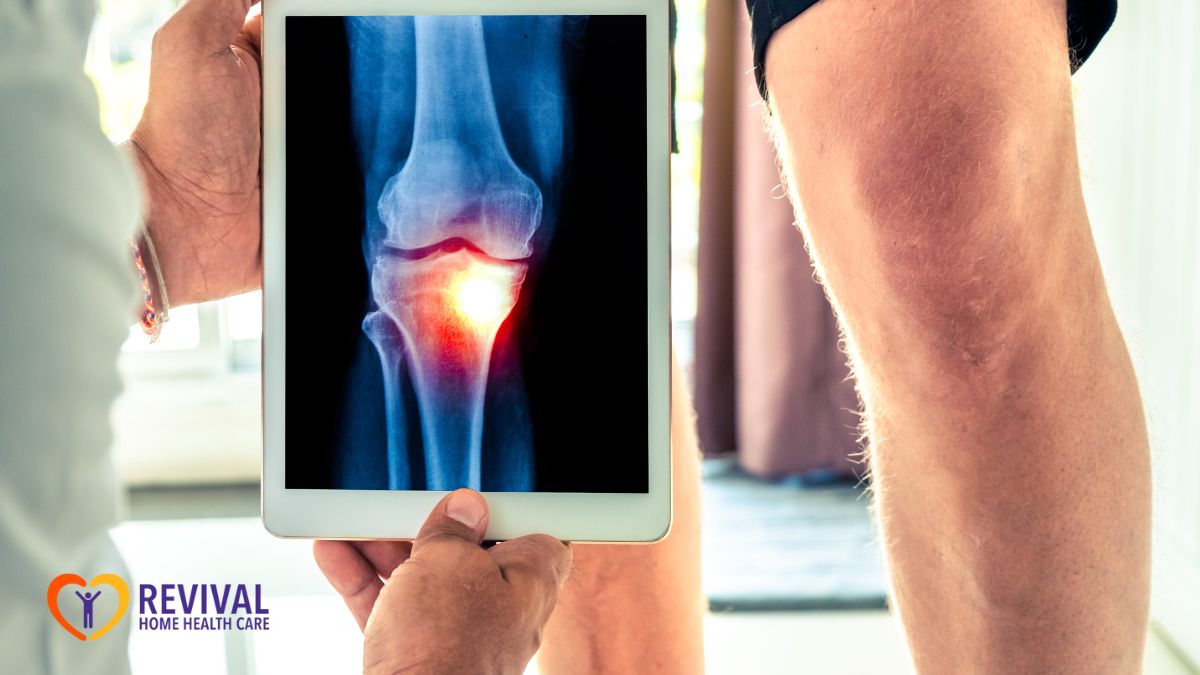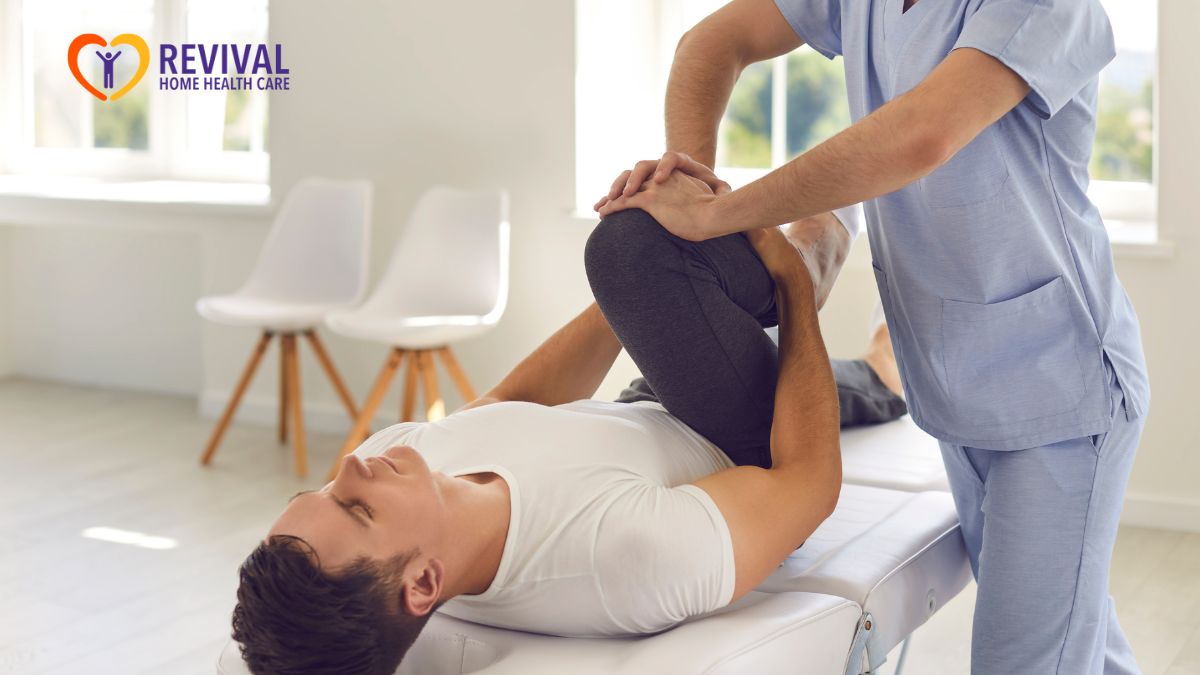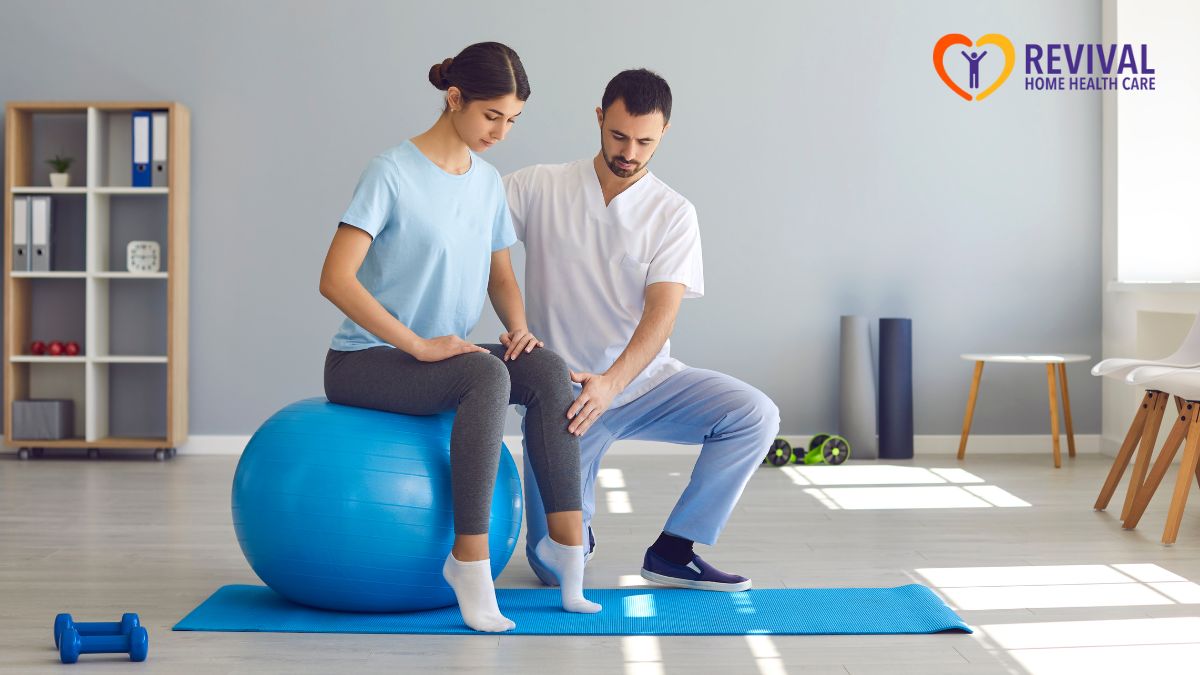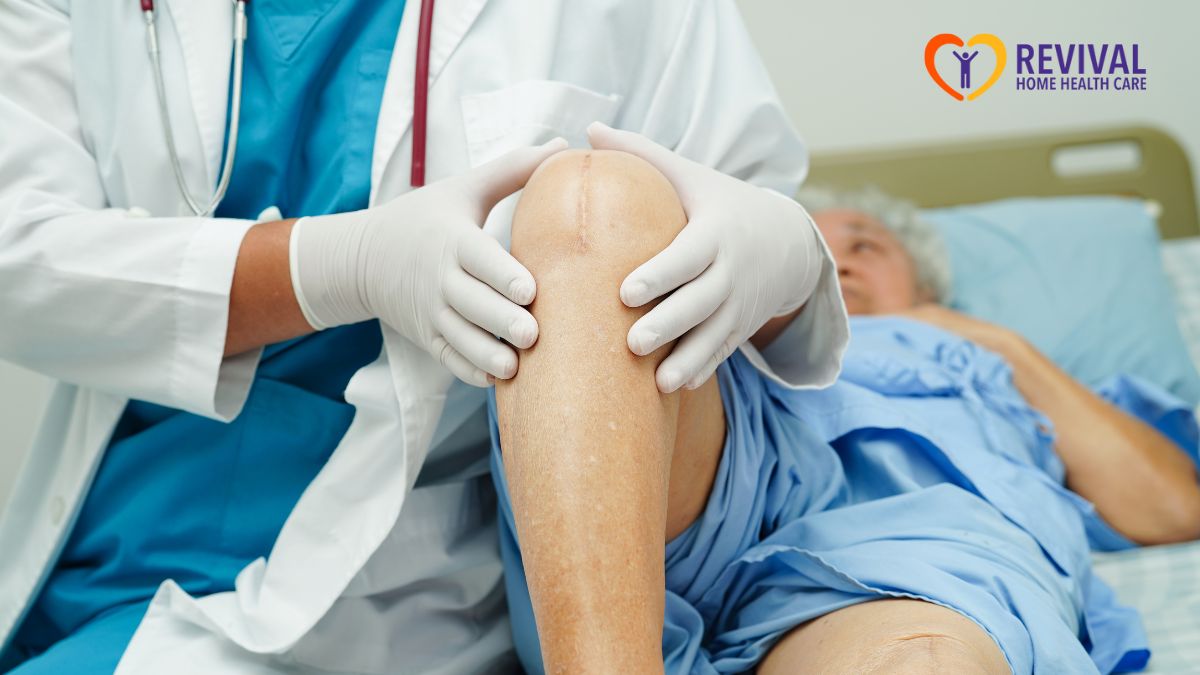Key Points:
- Home physical therapy after knee replacement progresses through weekly stages that build mobility, strength, and confidence.
- Weeks 1–2 target safe walking and basic motion, weeks 3–4 add endurance and balance, and weeks 5–8 build daily function.
- By Week 9–12, most patients walk 30 minutes and climb stairs safely.
Knee pain after surgery makes daily tasks feel slow and tiring. Home physical therapy after knee replacement gives structure so each week brings a clear win, from getting out of a chair with less help to taking stairs at your own pace.
Up next, you will see what to expect, how to set goals, and which safety habits prevent setbacks. Follow the weekly plan below to pace recovery and return to the routines that matter most to you.
 When Does Physical Therapy Start After Knee Replacement?
When Does Physical Therapy Start After Knee Replacement?
Most programs begin movement on the day of surgery or the next morning. Short, guided sessions start in the hospital and continue at home with a therapist within the first few days, mirroring how in-home physical therapy supports early recovery. Starting early reduces time in the hospital by about 1.8 days on average compared with older protocols.
If your case needs extra monitoring, your team may adjust the first-week plan. Ask your surgeon and therapist how long after knee surgery do you start physical therapy if discharge timing changes, and confirm eligibility details through your CHHA services coverage.
First-week checklist
- Practice ankle pumps, quad sets, and gentle heel slides three to five times per day.
- Use a walker for all transfers and indoor walks.
- Keep the leg elevated above heart level a few times per day.
- Apply cold packs as directed to manage swelling.
Home Physical Therapy After Knee Replacement: Week-by-Week Milestones
Home physical therapy after knee replacement builds routine and confidence through small, repeatable steps. Your therapist will tailor each session, but the milestones below show a typical path from Week 1 to Week 12. Use them to track progress and to plan daily tasks around energy levels.
Weeks 1–2: Foundation and Safe Mobility
Pain and swelling guide pace. Sessions will emphasize knee bending and straightening, quad activation, and safe gait with a walker.
Targets
- Walk indoors several times per day on level floors.
- Move from bed to chair and chair to standing with a walker.
- Practice gentle knee bends in a chair and on the edge of the bed.
- Begin short stair training with a railing if cleared by your therapist.
- Review home setup to lower fall risk.
Helpful tips
- Schedule pain medicine before therapy, as approved by your clinician.
- Keep pathways clear of cords, small rugs, and clutter.
- Write down three simple wins per day to reinforce progress.
Weeks 3–4: Endurance and Balance
Swelling should trend down. Many patients move from a walker to a cane at home as gait control improves. Therapy introduces balance drills and longer walks, similar to progressions common in in-home physical therapy programs.
Targets
- Walk indoors and start short outdoor routes if surfaces are flat.
- Increase sit-to-stand practice without using arms when safe.
- Add standing weight shifts and single-leg stance with support.
- Expand knee range with gentle holds at the end of each bend.
- Add light household tasks that require short standing periods.
Helpful tips
- Time walks after icing to keep swelling in check.
- Track total daily steps and increase by small amounts every few days.
- Ask your therapist when to add light resistance bands.
Weeks 5–6: Strength and Daily Function
Many patients can manage most self-care and light chores. Sessions progress to step-ups, mini squats to a chair, and controlled stair practice that build strength and balance over short, repeatable sets.
Targets
- Walk community distances with a cane or no device if gait is steady.
- Climb a flight of stairs with a railing using a step-through pattern when safe.
- Add mini squats, step-ups, and gentle stationary cycling if cleared.
- Resume basic errands with rides and short walks.
Helpful tips
- Use a checklist for “things you can’t do after knee replacement,” such as running, jumping, or pivoting sports, until your surgeon clears these activities.
- Keep swelling reviews in your log. A rise after activity means cut volume, not effort level.
Weeks 7–8: Return to Routines
Training shifts to functional tasks you care about most, with in-home occupational therapy helping translate drills to car transfers, shopping, and daily roles.
Targets
- Walk 15 to 30 minutes at a time on level routes.
- Practice car transfers and longer grocery runs with a cart for support.
- Add balance progressions on stable foam or varied surfaces.
- Increase resistance on cycling or band work if soreness resolves within 24 hours.
Helpful tips
- Use interval walks. Alternate two minutes at a moderate pace with one minute easy.
- Keep one recovery day between harder sessions to let the knee settle.
Weeks 9–12: Strength for Life
Focus moves to stamina and lower-body strength so daily tasks feel natural again. Many patients complete supervised care around this time and continue with a home plan, using telehealth check-ins for guidance between visits when needed.
Targets
- Walk 30 minutes most days of the week.
- Practice stair climbing without a railing if safe and approved.
- Add functional lifting drills that mirror household needs.
- Maintain a short flexibility routine morning and evening.
Helpful tips
- Use a weekly template. Two strength days, two balance days, and three walk days can cover most needs.
- Keep your home plan in visible places to sustain momentum after formal therapy ends.
 What Can You Do Safely At Home Each Week?
What Can You Do Safely At Home Each Week?
Pair therapy activities with routine tasks so practice happens without overthinking. Use timers and a log to stay consistent.
Daily rhythm example
- Morning: ankle pumps, heel slides, sit-to-stands, five to ten minutes of walking indoors.
- Midday: gentle knee bends, light chores, icing after activity.
- Late afternoon: short outdoor walk if the surface is flat, balance drill at the counter.
- Evening: stretch routine, leg elevation, and a final icing session.
Simple equipment list
- Two firm chairs with arms and a stable seat height
- Walker, then cane when cleared
- Cold packs and a compression wrap if recommended
- Non-slip bath mat and a shower chair
- Night light for hallways and bathrooms
How Long Should You Do Physical Therapy After Knee Replacement?
Most patients see a supervised plan run for eight to twelve weeks, followed by a longer home plan. Your timeline depends on pre-surgery strength, swelling patterns, and health conditions.
Keep weekly goals simple so it is easy to see progress in walking distance, stair skill, and balance time. Ask your team to adjust frequency if your energy drops or if pain spikes last beyond a day. The goal is steady practice, not big jumps that leave you sore the next morning.
A long-term plan protects your new joint. More than 90% of modern knee replacements still work well at 15 years when patients maintain activity and protect the joint from high-impact loads.
 What Are The Things You Can’t Do After Knee Replacement?
What Are The Things You Can’t Do After Knee Replacement?
High-impact moves stress the implant. Surgeons usually advise against running, jumping, and contact sports. Deep kneeling may feel uncomfortable even when safe. Twisting on a planted foot also increases strain, so pivot with small steps. Yard work and home projects are fine when broken into shorter blocks with rest and icing. If you are unsure about a hobby, ask your therapist to simulate the movement and check the form before you try it alone.
Everyday swaps
- Choose brisk walking or cycling instead of jogging.
- Pick low-impact classes over boot camps.
- Use a rolling stool for ground-level tasks instead of kneeling.
When Do You Start Physical Therapy After Knee Replacement?
Most programs launch on day zero or day one in the hospital and transition to home visits within the first few days. Starting within 24 hours shows better early function and a shorter length of stay compared with later starts, even though ultra-early sessions in the first 12 hours show little extra benefit.
Your team sets the first home visit based on discharge time, pain control, and home support. Tell your therapist right away if swelling rises sharply, if pain spikes last more than a day, or if you feel unsteady with transfers.
 Prevent Blood Clots While You Recover
Prevent Blood Clots While You Recover
Blood clots are a known risk after joint surgery, especially in the first three months. Simple daily steps lower that risk. Many clots form after patients go home, which is why home walking, ankle pumps, and in-home nursing for medication management matter so much. Recent data show about 60% of surgery-related clots appear after hospital discharge within 90 days.
Daily prevention list
- Walk short distances every couple of hours while awake.
- Do frequent ankle pumps when sitting or lying down.
- Use compression and take blood thinners as prescribed.
- Call your team for calf pain, sudden swelling, chest pain, or shortness of breath.
Red Flags That Need A Call
Quick action prevents setbacks. Do not wait if any of the signs below show up or if your gut tells you something is off.
Call your surgeon or therapist if you notice
- Fever over 100°F, wound drainage, or increasing redness
- Sudden swelling that does not settle with rest and icing
- Pain at rest that keeps you from sleeping
- A feeling that the knee is giving way during transfers or on stairs
- New numbness, tingling, or sharp calf pain
Motivation That Actually Works
Progress is easier when the plan fits your life. Use simple triggers and supports at home to keep going when energy dips.
Ideas to try
- Pair exercises with daily habits like coffee or TV time.
- Keep a small whiteboard on the fridge with today’s tasks.
- Ask a friend to walk with you once or twice per week.
- Celebrate non-scale wins like better sleep or easier car rides.
 Frequently Asked Questions
Frequently Asked Questions
Can you do physical therapy at home after knee replacement?
Yes. You can do physical therapy at home after knee replacement, especially in the first week. Home sessions focus on reducing swelling, walking safely with a cane or walker, practicing stairs, and building a repeatable daily routine. Your care team can adjust the plan for stairs or if you live alone.
What is the most important exercise after knee replacement?
Quad activation is the most important exercise after knee replacement. Strong quads support knee straightening, walking, and safe transfers. Start with quad sets and short holds, then add sit-to-stands and step-ups. Combine with ankle pumps and heel slides to improve motion and circulation through daily practice.
What is the most commonly reported problem after knee replacement surgery?
Stiffness is the most commonly reported problem after knee replacement surgery. Swelling often limits bending and straightening early on. Frequent walking, regular icing, and well-timed pain control support recovery. If motion stalls, therapy can intensify. Sudden redness, pain, or warmth requires immediate contact with your surgeon.
Get Home Physical Therapy Support In New York
Recovery improves when a licensed therapist guides your plan at home. Access trusted home health care services in New York so your schedule, home layout, and goals shape every visit.
At Revival Home Health Care, we provide personalized care that includes physical therapy, skilled nurse visits, medication support, and wound monitoring, delivered where you live. Call today to set up your evaluation or ask for next-step guidance so you can keep making steady gains.


 75 Vanderbilt Ave Staten Island, NY 10304
75 Vanderbilt Ave Staten Island, NY 10304 info@revivalhhc.org
info@revivalhhc.org 718.629.1000
718.629.1000